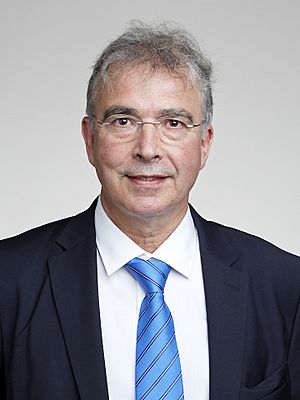John P. Burrows facts for kids
Quick facts for kids
John P. Burrows
|
|
|---|---|

Burrows in 2016
|
|
| Born | 16 August 1954 Liverpool, England
|
| Alma mater | University of Cambridge |
| Known for | SCIAMACHY |
| Scientific career | |
| Institutions |
|
| Thesis | Study of Free Radical Reactions by Laser Magnetic Resonance (1978) |
| Doctoral advisor | Brian Arthur Thrush |
John Philip Burrows, born on August 16, 1954, is a well-known scientist. He is a professor at the University of Bremen in Germany, where he studies the physics of the ocean and atmosphere. He also leads two important research centers there. Professor Burrows is also a Fellow at the Centre for Ecology and Hydrology, which is part of the Natural Environment Research Council.
Contents
Early Life and Education
John Burrows grew up in St Helens, England, and went to West Park Grammar School. He then studied at Trinity College, Cambridge. In 1975, he earned a degree in Natural Sciences. Later, in 1978, he completed his PhD. His research focused on understanding how certain chemicals called free radicals react. He used a special method called laser magnetic resonance for his studies.
Career Journey
After finishing his PhD, Professor Burrows worked as a researcher in the United States. He was at the Center for Astrophysics | Harvard & Smithsonian in Massachusetts. From 1979 to 1982, he worked at the Atomic Energy Research Establishment in Harwell, England. He then spent ten years at the Max Planck Institute for Chemistry in Germany. In 1992, he became a professor at the University of Bremen, where he has worked ever since.
Important Research
Professor Burrows's research has greatly improved our understanding of many important topics. These include air pollution, the ozone layer, and climate change. He and his team have studied how tiny particles and gases behave in the atmosphere. They have also created new ways to measure these things from the ground.
Studying Earth from Space
A big part of his work involves using remote sensing. This means studying Earth from far away, often with satellites. He worked closely with space agencies like the German Aerospace Center, the European Space Agency, and NASA. He started and led a major project called SCIAMACHY.
Satellite Missions
The SCIAMACHY project led to several important satellite instruments. These instruments measure gases in Earth's atmosphere from space. Some of these include:
- GOME on ESA's ERS-2 (from 1995 to 2011)
- SCIAMACHY on ESA's Envisat (from 2002 to 2012)
- GOME-2 on EUMETSAT's Metop Series (from 2006 to 2022)
His ideas also helped develop newer satellite missions. These include the European Union's Copernicus Programme Sentinel 4 and CarbonSat. These satellites help us monitor our planet and understand changes in its atmosphere.
Awards and Recognitions
Professor Burrows has received many awards for his scientific work. He is a fellow of several important scientific groups. These include the American Association for the Advancement of Science and the American Geophysical Union.
Some of his notable awards are:
- The William Nordberg Medal from the Committee on Space Research in 2006.
- The NASA Group Achievement Award in 2008.
- The Haagen-Smit Prize in 2012.
- The EGU Vilhelm Bjerknes Medal in 2013.
- The IUGG Silver Medal in 2015.
- The Alfred Wegener Medal in 2016.
In 2016, he was also elected a Fellow of the Royal Society. This is a very high honor for scientists in the United Kingdom.

